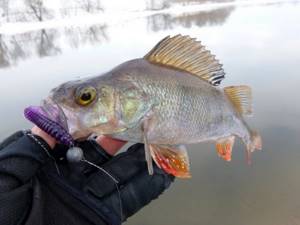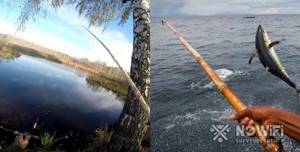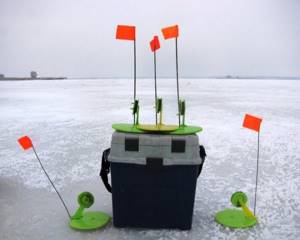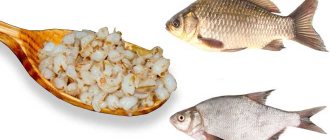We don’t always have the opportunity to take a fishing rod with us on vacation, or, on the contrary, we deliberately refuse to use it. And sometimes situations that go beyond the scope just happen. One way or another, when there is no gear or special bait at hand, fishing becomes an activity that requires ingenuity, creativity and, of course, remarkable dexterity.
We will look at a variety of methods, among which there is something to your liking.
Pit trap
On the shore of the reservoir you need to dig a hole and connect them using a shallow ditch (Figure 1). Place bait, such as bread, into the hole.

Figure 1. Pit trap
A hungry fish will swim into an artificial puddle on its own, and then you need to block its return path through the connecting channel. It can be blocked with a stone or log of a suitable size. After this, it is easy to catch the fish with your hands or some kind of container.
Plastic bottle trap
Plastic water bottles are always faithful travel companions. In addition to its direct purpose, an empty bottle can become an alternative means for fishing. Cut off the neck of an empty plastic canister of 2.5-5 liters and put bait inside (Figure 2).

Figure 2. Fishing with a plastic bottle
If the bottle is too wide, you can turn the cut part upside down and secure it to form a funnel. In order for the trap to be easily lowered into the water, you need to make small holes in it.
The next step is to lower it into the pond, with the open part towards the current.
To prevent the trap from being carried away, place something heavy but small in it.
The way it works is simple: the fish swims inside for the bait and cannot turn around to swim back out. All that remains is to get the trap with the caught fish.
Unusual, unconventional fishing methods
In this article I would like to share some not entirely standard fishing methods that have already been well forgotten, and some did not even know about them. They have been tested for many years and show good results, but are very rarely used in practice for the reason that today there is a huge variety of all kinds of fishing gear available to everyone.
Galoshes and glass jar. This funny and very effective method has been used for a long time, especially in rural areas, where floats and hooks for catching small fish were not available for sale. So, the cut-off toe of a galosh with a cut hole 2-3 cm in diameter was inserted into the neck of a glass jar, while bait was placed at the bottom of the jar - bread, cake, and the jar itself was attached with a thin rope or wire to any object, for example, a bush / tree and lowered to the bottom. Sometimes, in some situations, this trap would catch more fish in one day than could be caught with a fishing rod.
Meanwhile, in our time this method has not yet been completely forgotten. Children living or vacationing in villages use this method, only instead of galoshes they place the topmost part of the bottle, cut off with the neck, into the middle of the jar. We get the same trap: once in the middle of the jar, the fish will no longer be able to get out of it.
Coffee can and light bulb. This option should be used in large bodies of water, for large fish and at night. As you know, fish at night tries to stay closer to the water surface and remains in a half-asleep state. This knowledge was used.

The boat (raft) is equipped with a car battery with a voltage of 12 volts. A 12-volt light bulb is connected to the coffee can, for example, from a tractor headlight and through wires attached to the battery, it is placed under water at a distance of 20-30 cm. Under water, the light bulb will light up, and the coffee can will act as a reflector , it turns out something like an underwater lantern. In the process of such fishing, maintaining silence is of great importance, otherwise you can scare away the sleepy fish. Then, as fishing is carried out with a long metal rod, with a well-pointed end and an eye attached to the end (like the eye of a fishing hook), we have something like a harpoon.
Moving smoothly on a boat, having noticed a dormant fish, a rod is silently and slowly inserted under the water and precisely pierced through the entire body of the fish. An eye placed on the rod does not allow the prey to slip off, and the fish is caught as a result. As a result of the first catch, it is worth waiting a while for the fish, frightened by the noise, to calm down again, and resume fishing.
Let us remind you once again that with this fishing method it is necessary to carefully observe silence. Please note that you need to take the battery with you freshly charged, and not take it out of the vehicle you used to go fishing. In the process of powering a light bulb in water, there is an increased discharge of the battery, so when using the battery from a vehicle, there is a huge risk of remaining in the same body of water, unable to start the engine of your car.

TV. This rather unusual and not at first outstanding and unlikely method of fishing was described by one fisherman in the newspaper. In winter, sitting near an ice hole, a fisherman pulls out one fish after another, while the neighboring fishermen have no bite at all. The reason is very simple and interesting. In his hole there was a three-liter jar tied on a fishing line, and in it there was a ruff and another fish that didn’t get along with the ruff.
The idea is that there are two fish in the jar, chasing one after another, luring the rest of the fish with their restless behavior, this is the bait, this is the reason for the good bite.
Homemade prison
The most primitive spear is not difficult to make on site. It is enough to find a thin, strong tree and sharpen one end of it. It is better to make a point with four edges, because a round fish is more likely to fall off (Figure 3).

Figure 3. Fishing with a homemade spear
You won't be able to fish with a spear from the shore - you need to go into the water and sprinkle bait around you. Porridge or bread is quite suitable for this. Then everything depends on your dexterity, because this method of fishing requires certain skills and dexterity.
Harpoon or bow
Those who are proficient in archery will enjoy fishing with special fishing arrows. If you don’t have any, a harpoon will come to the rescue. True, in both cases you need good accuracy and an eye (Figure 4).

Figure 4. Fishing with a bow
An arrow or harpoon must be tied with fishing line or nylon thread so that it can be removed from the water.
For hunting with a bow or harpoon, it is very important to find a suitable place so that the surface of the water is clearly visible and nothing prevents you from making a shot or throw.
It will take some practice, as water distorts the image, you will need to get used to it to hit the target.
Fishing line on hand
This method is perfect for catching goby at sea. You need to take a fishing line or thin cord, tie a hook or even several if there are a lot of fish. If necessary, tie on a sinker (Figure 5). We bait the hooks using small fish cubes, mussels or other suitable bait.

Figure 5. Fishing with a fishing line
It is best to fish using this method from a pier or boat. When fishing from the shore, casting the line from your hand should be much stronger. Then all you have to do is wait, pulling the line a little to feel the bite. As soon as you feel jerks at the end of the line, hook and pull the prey out of the water.
What fish to catch and what baits to use
Having decided on the fish that we are going to catch, we can also decide on the baits that we will use when fishing.
We have compiled a table in which we have added all the basic baits and the most popular fish that are easiest to find in most bodies of water.
| Bait / Equipment | Perch | Pike | Rotan | Zander |
| Spinner | 2-3 cm (+) | 4-6 cm (+) | (-) | (-) |
| Oscillating spoon | 2-3 cm (-) | 5-8 cm (+) | (-) | (-) |
| Twister on jig head | 2-3 cm (+) | 5-8 cm (-) | 2-3 cm (+) | 4-6 cm (+) |
| Twister on a lead leash | 2-3 cm (+) | 5-8 cm (-) | 2-3 cm (+) | 4-6 cm (+) |
| Wobbler | 2-5 cm (+) | 5-10 cm (+) | (-) | (-) |
Each cell contains information about the recommended body size of the bait. And in brackets under the signs (+) and (-) the probability of catching this fish with a similar bait is indicated. A plus indicates a high probability, a minus indicates a low probability. If there is only a minus in the cell and the dimensions are not even indicated, then such a bait is not intended for catching a specific fish and it is better to change the bait.

For beginners, we recommend starting with perch fishing. This is the most common predator that can be found in almost any pond, lake, river, as well as from the shore in large reservoirs or bays.
List of the best lures for catching perch:
Rotating spinner. For example: Mepps 2 or 3 sizes. This company makes very high-quality and intensively rotating spinners, and this quality is very important for catching a striped predator.
The fishing technique is very simple: throw the lure in different directions (no more than 2 times in the same direction to catch as much water area as possible). Experiment with wiring depth. Keep the spinning rod pointed to the side to keep the line taut. Wait for the line to sag - this signals that the spoon has reached the bottom. Make a jerk and start wiring. The turntables are driven uniformly. You will have to find the speed experimentally. Start with more intense ones, gradually reducing the speed if there are no bites. Low-quality cheap spinners usually require faster retrieval, since when slow they either do not spin at all or spin sloppily, not attracting a predator at all.

Twister on a jig head when fishing with a stepped retrieve. Twisters are silicone baits with a soft tail that plays as it moves in the water. The softer and more sailing in shape the tail, the more vibrating its game is, and this is very important when catching perch, since it loves a large number of small high-frequency vibrations. A jig head is a weight connected to a hook. In some variations it is attached tightly, and in others it is hinged ring to ring.

Twister on a jig head connected to a hook with a ring-to-ring joint.
Step retrieving involves casting, waiting for the bait to drop to the bottom, and then reeling in 1-4 turns of the reel and then waiting for the bait to drop to the bottom. Repeat the cycle until you remove the bait from the water. A novice angler may encounter the problem of snags on snags, so to begin with, try to choose places where there are not many snags. On any pond or river there are places with and without snags. If you have already received one hold, it is better to change the place.
Rules for choosing a twister. For perch, it is important to choose the right size bait and jig head.
If you are targeting a body of water where large perch are a rare occurrence, then better concentrate on the little things, and therefore choose twisters 2-3 cm long. The jig head for such a twister should not weigh more than 7 g. In most cases, 5 is enough. But this is if you fish with an ultralight spinning rod. If you have a more powerful spinning rod, and the pond still involves catching only small things, use a universal equipment - a retractable leash. The twister material itself should be soft and elastic. The shape of the tail is sailing. Silicone beads at the tip of the tail are an additional positive factor that improves the oscillation frequency of the bait. After testing several twisters with wiring in the water and observing the game, you will see that some baits play creating a lot of vibrations, while others fluctuate weakly or do not fluctuate at all at a slow or even medium speed of wiring. It is better not to use such twisters.You need to attach the twister evenly so that when retrieving the bait, it moves smoothly in the water, without spinning along its axis. If it spins, replant it, otherwise there will be no bites.
Twister on a retractable leash. The second name of this equipment is Moscow equipment. The word “rigging” itself means the correct fastening of all elements of the gear in order to gain some advantage in specific fishing conditions compared to the usual fastening of the bait directly to the fishing line (or through a swivel).

Diagram of the device “Discharge leash”
The retractable leash has a sinker at the end of the fishing line weighing from 5 to 10-15 g, depending on the fishing conditions (depth, current strength). 20 cm higher along the line (towards the tip of the rod) a fluorocarbon leash 1 meter long (less often 1.5 meters) is attached. At the tip of this leash there is a twister on an offset hook. The offset hook allows you to attach the bait with the hook tip almost hidden. And it is hidden in such a way that when passing through the grass, it does not catch it, and when hooking a fish, it hooks it in 90% of cases.

These three baits and equipment are enough to start your spinning career. An oscillating spoon is good for catching pike and the fishing technique is very similar to a rotating spoon. Wobblers deserve a separate article, or rather even a series of articles and many discussions of the nuances in various conditions. Read our basic guide to catching pike with wobblers.
Stick and sinker method
The method is similar to fishing with a line by hand, but a stick or rod is used as a holder for the line and fishing rod. Thanks to this, the line will not cut your hands under heavy load (Figure 6).

Figure 6. Fishing with a stick
You will need a strong stick on which you need to carefully wind the fishing line, and it will act as a reel. Tie a hook to the end of the line and a sinker about 30 cm from it. Cast them into the water with a spinning motion, pointing the reel towards the target to make it easier to unwind. Keep the line slightly taut, and when the bite starts, wind it back onto the makeshift reel, pulling out the fish.
Unconventional fishing methods
Fishing is one of the oldest types of activities, which, despite its “antiquity,” has not lost its relevance to this day. And even though now this is no longer one of the main ways of obtaining food, but even in the age of new technologies, various gadgets and other innovations, there are those for whom this is a hobby and some kind of outlet.

And if earlier, several thousand years ago, people had only one way of catching fish - skewering them on a spear, but now, even in this direction, humanity does not stand still. Sometimes you are surprised how inventive a person can be, inspired and literally burning with his passion! How many new and original ideas come to him! Therefore, nowadays, along with traditional methods, more and more new, unusual and, most importantly, effective methods are appearing even for such a seemingly simple matter as fishing.
Method 1: fishing with a jar.
Yes, this may seem very funny to you, but still practice shows that even this way you can catch an amount of fish that “traditional” fishing methods cannot even dream of.
Read: Catching a predator with an elastic band
In fact, everything is very clear. You need to put a properly soaked piece of bread at the bottom of the jar. The jar needs to be tied with a thread to its neck and lowered into the water. It’s no wonder that after such a trick the fish swim into the jar to enjoy the fisherman’s treat. All that needs to be done in the future is to carefully lift the jar, cover it so that the prey, God forbid, does not jump out. Of course, it is impossible to catch large fish in this way, but if you do this for pleasure or for the desire to enjoy fried fish, then this option may be suitable.
Method 2: kwok.
This method is very unusual and requires special skills: for this you need to become a professional, in other words, a quoker, because this method is not the simplest. The quok is used to catch catfish. And who didn’t know: catfish are lovers of great depths. What is a kwok? A kwok is a stick, either metal or wood, with a foam or polymer ball. If you hit the surface of the water with this device, it will make a croaking sound that reminds a fish of a frog. At the same time, from the other end, you need to lower the baited hook to a shallow depth. The catfish, having heard such a pleasant sound for him, strives for the bait and grabs it. It’s much easier to catch fish this way. The difficulty with this method is to be able to learn how to make such sounds
Read: Sinker for float tackle
Method 3: fishing with a donk
People also call it fishing with an elastic band; as a rule, the second option is more often recognizable. This tackle consists of a large sinker to which a fishing line is tied. Between the fishing line and the sinker you need to insert a piece of rubber cord, but it is very important - the cord must be strong and elastic. You need to attach leashes with 3-6 hooks to the fishing line, since all the gear is wound on it. The fisherman must cast the sinker so that the hooks are at a relatively large distance in the water, make a stretch and be sure to secure the reel on the shore. If the line vibrates, congratulations, you got a bite! Using this method you can get several fish at once.
Method 4: circle fishing
It is one of the most effective methods. It is most often used to catch pike and pike perch. But there is one caveat - it is better to fish with such gear on rivers without strong vegetation and with quiet, deep bays. The reason for this choice is that the easily movable circles will cling to the grass if there is a lot of it there.
Read: About the Tyrolean for beginners: fishing with a Tyrolean stick
The essence of this fishing is that a plastic pin is inserted into a circle with a hole in the center, which is both a keel and a line holder. At the bottom of the keel there is a rather noticeable ball of bright color. A groove can be seen at the top of the keel. There the line is thrown over and then lowered, fixing on the side of the mug in the recess.
As a result of this, when a bite is expected, the circle begins to move across the pond with the red side up. When the fish grabs the tackle, the circle overturns and then turns white.
In general, how to fish is a matter for everyone. This article only provided an overview of some of the possible options. We hope that out of all these methods, there will be one that will bring someone true fishing pleasure and many enviable trophies!
Subscribe to
our channel in Yandex Zen
Bear Grylls method
This is the trick used by TV traveler Bear Grylls when traveling through the Scottish Highlands.
To use this method, you need to find a bottleneck in a stream or a small channel between two bodies of water. From stones and logs, build a low dam in this place, with a small hole in the middle, which will be the only passage for fish (Figure 7).

Figure 7. Fishing using the Bear Grylls method
Stretch a net, bag or fabric between the stones in the passage and secure it so that the fish can swim into it. Now it remains to make sure that the fish swims in the direction we need. Throw a few small stones into the stream or beat the water with a rod so that the fish are scared by the noise. Disturb the pond and make noise until the fish begins to swim towards the nets where they can be caught.
Rubber
Another interesting tackle. Sometimes it is also called donka, but among ordinary people, gum is a more recognizable name. This tackle consists of an impressively sized sinker to which a fishing line is attached. A piece of rubber cord is inserted between the line and sinker; it must be strong and elastic. Leashes with hooks (usually 5-7 pieces) are attached to the fishing line that is closer to the reel (on which all the tackle is wound).
The fisherman casts the sinker so that the hooks are at a fairly decent distance in the water, makes a stretch, fixes the reel on the shore, and judges whether the fish is biting by the vibration of the stretched fishing line near the reel. The method is very interesting, practically you have 5-7 float rods in one hand. You can often land several fish at once, and that's all the fun.
So, in short, we went over the main methods of fishing. You just have to choose to your taste, although I am sure that each piece of gear will bring you a lot of positive experiences. There are, of course, many other ways, but I decided to leave the other authors at least a little something to talk about, not just me alone. And in the next conversations I will tell you about the ancient methods of catching predatory fish, I will teach you how to use a balabaika correctly and where is the best place to place the stavushi.
(Visited 363 times, 2 visits today)
Using bright colors
Fish are attracted to bright colors and shine in the water. You can use pieces of plastic or wood chips painted with nail polish for bait (Figure 8).

Figure 8. Options for using bright colors
To fish, you just need to make a simple fishing rod from a rod and fishing line, and place a bright object on the hook. Having lowered the line into the water, move it a little to draw attention to the bright spot.
Photos of winter fishing rods

Note!

How to attach live bait to a girder - the best methods and step-by-step description of how to properly attach live bait (115 photos and videos)
Flags for winter fishing - choice of gear, methods of catching predators and an overview of the most effective techniques (120 photos)

Winter baits: useful tips on choosing gear, secrets of experienced fishermen and features of their use (video + 110 photos)
Read here Fishing with a balance beam in winter - a detailed guide and important nuances of fishing with a balance beam in winter fishing (115 photos)
Help the project, share on social networks 

0
Fishing with bare hands
This option is applicable for small streams and reservoirs with steep banks and muddy bottoms.
You need to slowly probe the bottom of the reservoir with your hands towards the shore.
Having found the fish, you need to press it to the bottom, or grab it behind the gills, but this requires dexterity and quick reaction (Figure 9).

Figure 9. Catching fish with bare hands
Fishing in muddy water
If the reservoir is fishy, you can raise silt from the bottom, which will make the hunter invisible to the fish and at the same time force him to look for its clean water. When it rises to the surface, you can jam it with a stick, catch it with a container or bare hands, or use other methods (Figure 10).

Figure 10. Fishing in troubled waters











